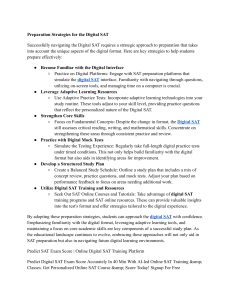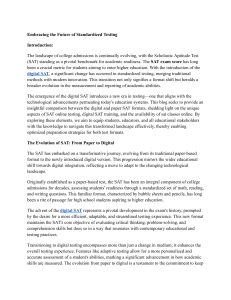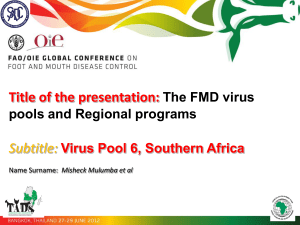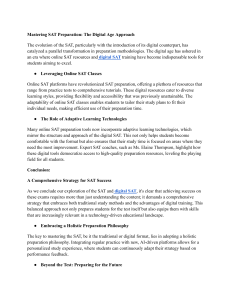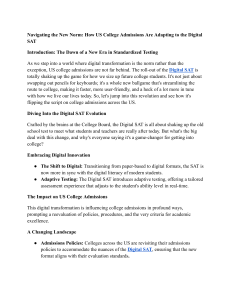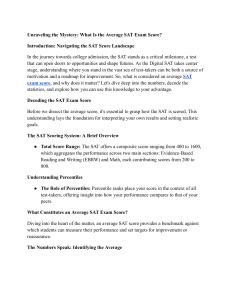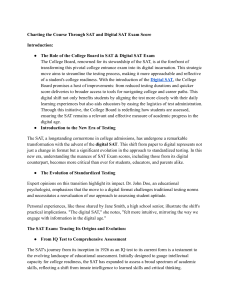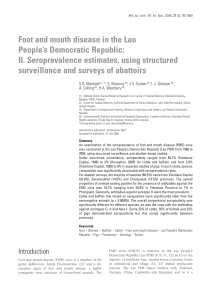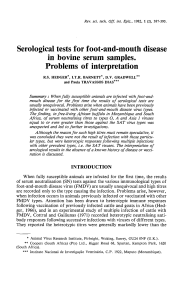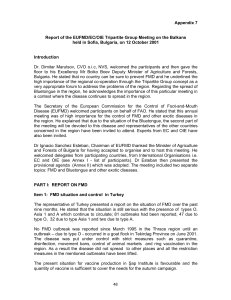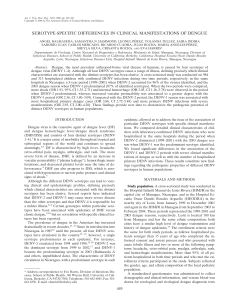D469.PDF
publicité
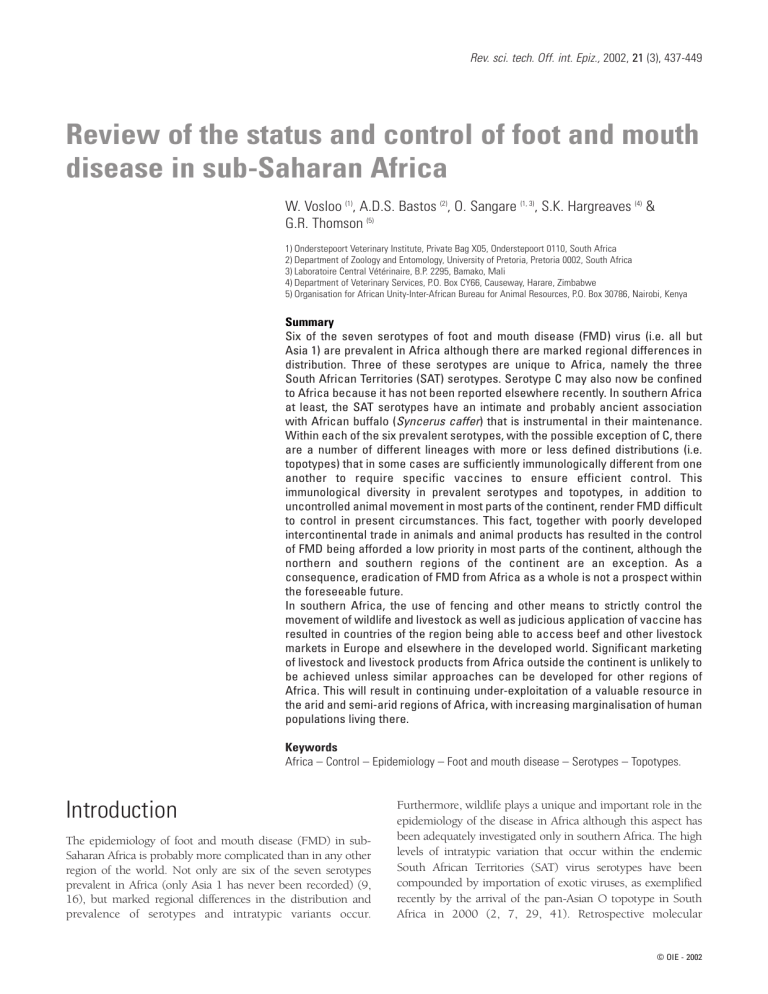
Rev. sci. tech. Off. int. Epiz., 2002, 21 (3), 437-449 Review of the status and control of foot and mouth disease in sub-Saharan Africa W. Vosloo (1), A.D.S. Bastos (2), O. Sangare (1, 3), S.K. Hargreaves (4) & G.R. Thomson (5) 1) Onderstepoort Veterinary Institute, Private Bag X05, Onderstepoort 0110, South Africa 2) Department of Zoology and Entomology, University of Pretoria, Pretoria 0002, South Africa 3) Laboratoire Central Vétérinaire, B.P. 2295, Bamako, Mali 4) Department of Veterinary Services, P.O. Box CY66, Causeway, Harare, Zimbabwe 5) Organisation for African Unity-Inter-African Bureau for Animal Resources, P.O. Box 30786, Nairobi, Kenya Summary Six of the seven serotypes of foot and mouth disease (FMD) virus (i.e. all but Asia 1) are prevalent in Africa although there are marked regional differences in distribution. Three of these serotypes are unique to Africa, namely the three South African Territories (SAT) serotypes. Serotype C may also now be confined to Africa because it has not been reported elsewhere recently. In southern Africa at least, the SAT serotypes have an intimate and probably ancient association with African buffalo (Syncerus caffer) that is instrumental in their maintenance. Within each of the six prevalent serotypes, with the possible exception of C, there are a number of different lineages with more or less defined distributions (i.e. topotypes) that in some cases are sufficiently immunologically different from one another to require specific vaccines to ensure efficient control. This immunological diversity in prevalent serotypes and topotypes, in addition to uncontrolled animal movement in most parts of the continent, render FMD difficult to control in present circumstances. This fact, together with poorly developed intercontinental trade in animals and animal products has resulted in the control of FMD being afforded a low priority in most parts of the continent, although the northern and southern regions of the continent are an exception. As a consequence, eradication of FMD from Africa as a whole is not a prospect within the foreseeable future. In southern Africa, the use of fencing and other means to strictly control the movement of wildlife and livestock as well as judicious application of vaccine has resulted in countries of the region being able to access beef and other livestock markets in Europe and elsewhere in the developed world. Significant marketing of livestock and livestock products from Africa outside the continent is unlikely to be achieved unless similar approaches can be developed for other regions of Africa. This will result in continuing under-exploitation of a valuable resource in the arid and semi-arid regions of Africa, with increasing marginalisation of human populations living there. Keywords Africa – Control – Epidemiology – Foot and mouth disease – Serotypes – Topotypes. Introduction The epidemiology of foot and mouth disease (FMD) in subSaharan Africa is probably more complicated than in any other region of the world. Not only are six of the seven serotypes prevalent in Africa (only Asia 1 has never been recorded) (9, 16), but marked regional differences in the distribution and prevalence of serotypes and intratypic variants occur. Furthermore, wildlife plays a unique and important role in the epidemiology of the disease in Africa although this aspect has been adequately investigated only in southern Africa. The high levels of intratypic variation that occur within the endemic South African Territories (SAT) virus serotypes have been compounded by importation of exotic viruses, as exemplified recently by the arrival of the pan-Asian O topotype in South Africa in 2000 (2, 7, 29, 41). Retrospective molecular © OIE - 2002 438 Rev. sci. tech. Off. int. Epiz., 21 (3) epidemiological studies show that transcontinental introductions of virus types A and O have also occurred in the past (25, 29). remain unrecorded. There are several reasons for this, as follows: – most countries are not involved in intercontinental trade in animals and animal products and therefore have little outside inducement to report the disease Foot and mouth disease is endemic in nearly all countries of sub-Saharan Africa (Fig. 1) but the majority of outbreaks 1975: 2 1976: 2 1997: A 2000: O 1975: 2 1979: 2 1980: 2 1983: 2 1996: A 1997: A 1979: 2 1980: 2 1998: A 1999: O 1977: A 1983: A 1991: O 1992: O 1999: O Morocco Tunisia 1959: O 1960: O 1962: O 1967: O 1968: O 1972: O 1979: A 1981: O 1982: O 1983: O 1988: O 1989: O 1994: O 1961: A 1962: A 1963: 1, 2, O 1964: 1, A 1965: A 1966: A 1967: A 1968: 1, A 1970: 1, A 1971: A 1972: 1, A 1973: 1, 2 1974: 2, A 1975: 1, 2, A 1976: 1, A 1979: 1, A 1980: 1 1981: 1, 2 1982: 2 1958: O, A 1961: O 1964: O 1965: O 1967: A 1970: O 1972: A 1974: O 1983: O 1987: O 1989: O 1993: O 2000: O 1963: 1 1964: 1 1972: 1 1973: A Algeria Libya Western Sahara Egypt 1991: 2 1997: A 1999: O,A,2 1958: O 1960: A 1961: 2, A 1962: 2 1965: 2 1967: A 1968: 1, 2 1969: 1 1971: A 1972: A 1973: 1, 2, A 1974: 2, A 1990: 2 1991: 2 1993: O 1994: O 1996: A 1966: O 1977: A 1990: O 1999: O 1965: C 1967: C 1969: C 1970: O 1975: O 1979: A 1982: A 1989: O 1990: O 1994: O 1999: O Mauritania Mali Gambia 1996: O 1997: A 1998: A, 2 Niger Senegal Burkina Guinea Faso Guinea Bissau Togo 1961: A 1969: O Sierra Benin Leone Liberia 1999: O Côte d’Ivoire Ghana 1990: 2 1974: 2, A 1971: A 1974: 2 1975: 2 1990: 2 1995: O, A 1996: A 1999: O 1964: 2 1965: 2 1969: 2 1973: 1 1974: 1 1975: 2 1976: O 1979: 1 1980: 1 1981: 1, 2, C 1982: 2, O 1987: 1 1988: 1 1990: 1, A 1992: 1 1999: 1, 2 2000: 1 1964: 2 1992: O 1994: A 1975: A 1976: A 1985: A 1986: A 1987: A 1988: O 1989: O 2000: A, 2 1958: 1, 3 1959: 2, 3 1960: 2 1961: 1, 2, 3 1965: 1 1967: 2 1968: 1, 2 1969: 2 1970: 2 1971: 1 1973: 1 1974: 1, 2 1975: 1 1977: 2 1978: 2 1979: 1, 2, 3 1980: 1, 3 1981: 1, 2 1983: 2 1986: 2 1988: 1, 2, 3 2000: 1, O 2001: 2 Nigeria Ethiopia 1959: 2 1962: O 1966: A 1967: A 1968: A 1970: 1 1971: 1 1973: 2, A 1974: O, A 1975: 2, O, A 1976: 3 1981: A 1982: O 1985: O 1998: O 2000: 1 Somalia Cameroon Central African Republic Equatorial 1967: A Guinea 1971: A 1973: A, 2 Gabon 1976: 1 1988: O 1959: 2, O 1963: 2 1958: A 1959: A 1961: A 1962: O 1963: A 1965: 2 1966: A 1967: O, A 1968: 2, A 1969: 2, A 1970: 2, A 1971: A 1972: 1, A 1973: O, A, C 1974: 1, 2, O 1975: O Eritrea Sudan Chad Congo Democratic Republic of the Congo Uganda Kenya Rwanda Burundi Tanzania 1974: 2 1979: 2 1982: 2 Zanzibar Angola 1980: O, A 1984: O 1986: 2, O 1990: A 1991: 2 1999: 1,2,O Malawi Zambia Namibia Zimbabwe Mozambique Botswana 1961: 1 1962: 1, A 1964: 1 1967: A 1968: 2 1969: 2 1970: 2 1971: 2 1975: 2 1978: 2 1980: 1 1989: 1, 2 1990: 1, 2 1991: 2 1992: 2 1994: 3 1958: 2 Swaziland 1959: 3 1960: 2 1964: 1, 2 1965: 1, 2 South Africa 1966: 1 Lesotho 1967: 1 1969: 2 1960: 1, 3 1970: 2 1961: 1, 3 1971: 1, 2 1963: 3 1972: 2 1964: 3 1974: 1, O 1965: 3 1965: 1 1975: 1 1966: 3 1969: 2 1977: 1, 2 1968: 1 2000: 1 1978: 1, 2 1977: 1, 2 2001: 1 1979: 1, 2 1978: 1, 2 1980: 2, O 1980: 1, 2 1981: 1, 2 2002: 2 1983: 2 1960: 2, A 1962: O, A 1964: O 1965: A 1967: O 1969: 2 1958: 2, O, A 1959: 2, O, A 1960: 2, O, A 1961: O, A 1962: 2, O, A 1963: 2, O, A 1964: 2, O, A 1968: 2, O, A 1969: 2, O 1970: 2, A 1971: 1, O, A 1972: 1, 2 1975: 2 1977: 1 1980: 1, O, A 1984: O 1985: O 1986: 2 1996: 1, O 1998: O 1999: 1, 2 2000: 1, 2, O 1960: O 1992: 2 1996: 2 1997: 2 1998: 0 2000: 2 2001: 2 1961: O 1962: O 1963: O 1966: O 1969: O, A 1971: C 1979: O, A 1990: 2, O 1991: 2, O 1992: O, A 1993:O 1994: O, A 1995: O 1996: O 1960: O 1971: O 1976: 2 1977: O 1978: A 1980: O 1981: O 1983: O 1948: 1 1958: 1 1959: 1, 2 1960: 1 1961: 1, 2 1962: 1, 2 1964: 2 1965: 2 1966: 1, 2 1967: 2 1970: 2 1971: 2 1972: 1, 2 1973: 2 1974: 3 1975: 2, 3 1976: 1, 2, 3 1977: 2, 3 1978: 1, 2, 3 1979: 1, 2 1980: 1, 2 1981: 1, 2, 3 1983: 2, 3 1984: 3 1985: 1 1987: 2 1988: 1, 2 1989: 1, 2 1991: 2, 3 1997: 2 1999: 1, 3 2001: 2 1960: A 1961: 1, O 1963: 1, O 1966: A 1976: A 1968: A 1969: 1, A 1970: O 1971: O 1973: O, A 1974: 1, O 1975: O, A 1976: 1, O 1977: 2, O, A 1979: O 1980: O 1981: A 1982: A 1983: O 1984: A 1985: A 1986: O 1989: O 1999: O 1958: 2, O, A 1959: 1, 2, O, A 1960: A 1961: 1, O, A 1962: 1, O, A 1963: O, A 1964: O, A 1965: O, A 1966: 2, O, A 1967: 2, O, A 1968: 2, O, A 1969: 2, O, A 1970: 1,2,3,O,A,C 1971: 1,2,O,A,C 1972: 1, 2, O, A 1973: 1, 2, O, A 1974: 1, 2, O, A 1975: 2, O, A 1976: 2, O, A 1978: 1, O 1991: 2, O 1995: 2 1996: 2, O 1998: 2, O 1999: 1, 2 2000: O 1958: 2, O, A 1959: 2, O, A 1960: 2, O, A, C 1961: 2, O, A 1962: O, A, C 1963: O, A, C 1964: O, A, C 1965: O, A, C 1966: 2, O, A, C 1967: O, A 1968: O, A 1969: 2, O, A, C 1970: 2, O, A, C 1972: 1 1976: 2, A 1984: 2 1985: 2 1986: 2 1987: 2 1988: 2 1989: 2 1991: 1, 2, O, A 1992: 2 1993: A 1994: 2 1995: 2, O, A 1996: 2, A, C 1998: 1, 2, O, A 1999: 1, 2, O, A 2000: 2, O, A, C O, A, C, 1, 2 and 3 indicate outbreaks of serotypes O, A, C, SAT 1, SAT 2 and SAT 3 respectively Fig. 1 Map of Africa demonstrating the typed outbreaks of foot and mouth disease between 1948-2002 Information was taken from Ferris and Donaldson (16) and kindly provided by the World Reference Laboratory, Animal Health Institute, Pirbright, United Kingdom, and the Exotic Diseases Division, Onderstepoort Veterinary Institute. The web pages of the Food and Agriculture Organization and the Office International des Epizooties (OIE: World organisation for animal health) were also consulted © OIE - 2002 Rev. sci. tech. Off. int. Epiz., 21 (3) – in many regions, especially where pastoral systems predominate, surveillance systems are inadequate or nonexistent – transporting suitable material from the field to a suitably equipped laboratory in order to confirm and type occurrence of FMD virus (FMDV) is logistically complicated and expensive – very few laboratories in Africa have the means to diagnose FMD adequately. Perhaps most important is the fact that nearly all livestock owners in Africa, and consequently animal health authorities in the countries concerned, do not view FMD as a serious disease. This is perfectly understandable because in the extensive livestock-raising systems practised in most parts of Africa, FMD is a mild disorder and has relatively little impact. It must be emphasised, however, that exceptions to this rule occur even among pastoralists who sometimes complain of the effects of the disease on milk production. In more sedentary communities, ploughing and draught capacity may be impaired. Thus, FMD in most of Africa is viewed in a very different light from the concept of the disease in more developed parts of the world where intensive livestock production is highly vulnerable to the effects of FMD. For that reason, limitations on the export of livestock and livestock products from sub-Saharan Africa to markets in the developed world will remain a constraint for the foreseeable future. The long-term result is likely to be that countries in Africa wishing to export livestock and livestock products will be forced to control FMD more effectively than hitherto. The corollary is that this is likely to divert resources away from animal diseases that impact directly on livestock in the sub-continent such as rinderpest, contagious bovine pleuropneumonia and a range of tick-borne diseases. Countries in southern Africa, contrary to the general trend in Africa, have been largely successful in controlling FMD to ensure access to international markets. Success in this direction has been achieved by preventing infection of livestock with FMD viruses by complex and strongly enforced movement control, based on permit systems and fencing, as well as frequent inspection of livestock in high-risk areas so as to detect disease and institute counter measures as soon as it occurs. The fencing systems have been used not only to assist in movement control of livestock but also to segregate domestic livestock from wildlife populations, especially African buffalo (Syncerus caffer). In areas where buffalo are present, cattle are generally vaccinated twice yearly as an additional measure. Vaccination is complicated by the fact that not only are the three SAT serotypes of FMDV prevalent in most southern African buffalo populations but also by considerable geographically-specific intratypic variation (topotypes) among these viruses (3, 7, 10, 15, 19, 37, 41). To complicate matters further, the use of fencing is increasingly questioned due to significant 439 environmental, social and economic costs that, some maintain, are unacceptably high (32). Most countries in sub-Saharan Africa other than those in southern Africa are ill equipped to face transboundary diseases because of lack of infrastructure and financial resources, ineffectual animal health authorities, civil unrest and, sometimes, military conflict. Furthermore, most governments ascribe low priority to animal diseases and control in the face of many other pressing problems in, for example, human health and education, although they realise that efficient livestock production is necessary to ensure food safety for vulnerable communities as well as for development in the longer term. Inevitably, increasing livestock production will necessitate intensification where possible. On account of the profound effects on intensive livestock production systems, FMD will ultimately constitute an increasing constraint on more efficient production as well as marketing of the surplus products enabled by expanded capacity. In this sense, FMD in Africa is likely to constitute a rapidly increasing problem. In southern Africa particularly, and especially in marginal areas prone to drought, there is considerable expansion of wildlifebased activities (game farming and establishment of large wildlife conservancies for ecotourism and trophy hunting) as these activities can be more profitable than conventional cattle raising (26). Wildlife enterprises have the potential to contribute significantly to the financial stability of many areas where other agricultural activities alone cannot ensure the prosperity of local inhabitants. However, FMD influences wildlife-based activities as well as livestock farming in the vicinity and, for that reason, the further development of wildlife-based enterprises will depend on overcoming the problem posed by African buffalo that maintain the SAT serotypes. The reason is that keeping infected buffalo in close proximity to livestock results in those animals being considered an acceptable risk in regard to trade in the animals or animal products. The value of livestock in areas in which infected buffalo occur is diminished because the sale of livestock and livestock products has to be regulated (and therefore limited) to prevent spread of FMD. The presence of FMD, for the same reasons, has a negative impact on the integration of livestock and wildlife-based activities, which is believed by many to be ecologically and financially desirable. The development of such activities will therefore depend heavily on the FMD control measures applied in the locality concerned. Currently, fences of increasing dimension are used to separate livestock from wildlife, while susceptible livestock may be vaccinated as a further control measure (34). Thus, FMD will continue to exert considerable influence on the development of integrated landuse policies in southern Africa. Whether this will occur in other parts of Africa remains to be seen but if intensification and commercialisation of livestock production develops to any extent, FMD will inevitably become a major factor. © OIE - 2002 440 Rev. sci. tech. Off. int. Epiz., 21 (3) Distribution of foot and mouth disease viruses in Africa Epidemiology of foot and mouth disease in Africa The officially recorded occurrences of FMD in Africa since 1948 are shown in Figure 1. Untyped outbreaks are not indicated. Foot and mouth disease viruses display high levels of genetic and antigenic variation (33). Previous and ongoing studies have shown that SAT viruses within each of the serotypes prevalent on the continent tend to evolve independently of each other in different geographic localities. The term ‘topotype’ is used to reflect the presence of genetically and geographically distinct evolutionary lineages (28). The numbers and distribution of topotypes for each of the SAT serotypes so far identified are summarised in Table I. Based on knowledge generated to date, SAT 2 viruses appear to be particularly diverse, with the largest number of topotypes, whilst serotype C, probably as a result of being the rarest serotype on the continent, has the fewest (7, 8, 25, 27, 29, 30, 31, 41). Topotype ‘richness’ in Africa is thus summarised as SAT 2 > SAT 1 = A > O > SAT 3 > C. However, it is emphasised that the apparent diversity of topotypes may change once results from studies addressing the underrepresented regions of East and Central Africa become available. Furthermore, topotype diversity does not appear to be influenced by serotype prevalence which is broadly described by SAT 2 > O > A > SAT 1 > SAT 3 > C (Fig. 1). In southern Africa, with the exception of Angola, the three SAT 1, 2 and 3 serotypes are almost exclusively prevalent. Serotype O was, however, recorded in Mozambique in 1974 and 1980 and the pan-Asian O topotype occurred in South Africa during 2000 (29). These viruses were shown by molecular studies to have been imported from Europe/South America and the Far/Middle East respectively (29). Foot and mouth disease caused by serotype A virus also occurred on two occasions in northern Namibia, presumably as extensions of the occurrence of the infection in Angola where ‘exotic’ serotypes occurred regularly up to 1975 when official reporting seems to have ceased (Fig. 1) (25). With the exception of Angola and the few occurrences of ‘exotic’ serotypes in Mozambique, Namibia and South Africa mentioned above, all other outbreaks of FMD have been caused by SAT serotype viruses (SAT 1 caused 58, SAT 2, 75 and SAT 3, 23 of the reported outbreaks) (Fig. 1). In Central Africa, serotypes O, A, SAT 1 and SAT 2 have been responsible for most outbreaks of FMD (Fig. 1). Serotype SAT 3 was recorded only once in Malawi in 1976, while serotype C also occurred only once, in Zambia during 1981. In West Africa, only serotypes O, A, SAT 1 and SAT 2 were recorded between 1958 and 2001. Most outbreaks were caused by serotype A (a total of 39), followed by 31 outbreaks caused by SAT 2, 15 by SAT 1 and 13 attributed to serotype O. SAT 1 has been recorded only in Niger, Nigeria and Ghana (Fig. 1). In North Africa, although not involved in detail in this discussion, serotypes A and O were recorded regularly since 1958, while serotype C occurred in Tunisia only during 1965, 1967 and 1969 (Fig. 1). East Africa has experienced outbreaks in cattle of five serotypes prevalent in Africa, although SAT 3 was recorded once in Uganda in 1970 in a carrier buffalo and is indicated here because of the importance of showing that SAT 3 is indeed present in the buffalo populations in that region (Fig. 1) (19). Serotype C occurred in Ethiopia in 1971, in Uganda between 1970 and 1971 and in Kenya in 1960, 1962-1966, 1969-1970, 1996 and 2000. This appears to be the only region of the world where this serotype has been found in recent times. This is interesting because serotype C seems to have disappeared elsewhere in the world and it has been postulated that the continued occurrence of this serotype in East Africa may be vaccine-related rather than due to natural persistence (24). Within the reporting period detailed here (Fig. 1), 95 outbreaks were caused by serotype O, while 73 could be attributed to serotype A. More outbreaks have been caused by SAT 2 (a total of 61) than the 26 ascribed to SAT 1. © OIE - 2002 Serotype O Serotype O is widespread in countries of Africa, north of the Equator. Recent evidence indicates that the presence of serotype O in countries of southern Africa is the result of introductions from other continents, and is therefore probably exotic to this region (29). These exotic topotypes (I and V) (Table I) have been recorded in South Africa and Angola. The former was due to the introduction of the globally dominant pan-Asian virus, whilst the latter appears to have been an historical introduction from Europe/South America (29). The remaining three topotypes (II-IV) occur in Africa alone, in three discrete regions, namely East Africa, north-west Africa and north-east Africa (28, 29). Serotype A In common with serotype O, serotype A predominantly occurs in countries of North Africa where the disease is endemic (16, 25). Sporadic reports of this serotype in North Africa (Morocco, Algeria, Libya, Tunisia and Egypt) and southern subcontinental regions (Namibia, Angola, Malawi and Zambia) appear to be due to introductions from other continents (25). Six distinct topotypes have been identified, five of which are unique to Africa (25). These endemic lineages are represented by topotype I, which is restricted to West Africa, whilst topotypes III to VI are distributed throughout the East African region. Topotype II represents the European/South American virus lineage that was introduced on four separate occasions to the continent (25). Of particular interest within serotype A is the presence of two independent evolutionary lineages (topotypes) within single countries. Kenya and Ethiopia have 441 Rev. sci. tech. Off. int. Epiz., 21 (3) Table I Topotype distribution of foot and mouth disease serotypes O, A, C and South African Territories types 1, 2 and 3 in Africa Serotype Topotype Representative country/countries SAT 1 I South Africa, southern Zimbabwe, Mozambique II Botswana, Namibia, western Zimbabwe SAT 2 SAT 3 O A C Reference/s III Zambia, Malawi, Tanzania, northern Zimbabwe IV Uganda V Nigeria VI Nigeria, Niger South Africa, Mozambique, southern Zimbabwe 31 II Namibia, Botswana, northern and western Zimbabwe III Botswana, Zambia IV Burundi, Malawi, southern Kenya 41 V Nigeria, Senegal, Liberia, Ghana, Mali, Cote d’Ivoire VI Gambia, Senegal Eritrea VIII Rwanda IX Kenya X Democratic Republic of the Congo XI Angola I South Africa, southern Zimbabwe II Namibia, Botswana, western Zimbabwe III Zambia IV Northern Zimbabwe V Uganda I South Africa 7 27 I VII 41 8 30 41 3 27 II Kenya, Uganda 28 III Algeria, Cote d’Ivoire, Guinea, Morocco, Niger, Ghana, Burkina Faso, Tunisia 29 IV Eritrea, Ethiopia, Tunisia, Egypt V Angola I Mauritania, Mali, Cote d’Ivoire, Ghana, Niger, Nigeria, Cameroon, Chad, Senegal II Angola, Algeria, Morocco, Libya, Tunisia, Malawi III Tanzania, Burundi, Kenya, Somalia, Malawi IV Ethiopia V Sudan, Eritrea VI Uganda, Kenya, Ethiopia I Kenya 25 27 SAT: South African Territories topotypes III and VI and topotypes IV and VI, respectively within their borders, whilst in Malawi both exotic (topotype II) and endemic (topotype III) lineages have been recorded (25). The exotic virus serotypes occurring in countries in North Africa (Algeria, Morocco, Tunisia and Libya), together with those from countries in southern and Central Africa (Angola and Malawi), are related to historical European and South American reference strains (25). Serotype C Serotype C appears to have disappeared from the world as a whole, with the exception of Kenya (24). Historically this is the rarest of the FMDV types to have occurred in Africa, having been recorded only in three countries, namely: Ethiopia, Kenya and Angola (Fig. 1). Published sequence data is presently limited to a 1996 strain from Kenya, which when compared phylogenetically to type C viruses occurring world-wide, appears to belong to an African/Middle East-specific topotype (27). Further genetic characterisation is required to determine whether this serotype was introduced to East Africa from the Middle East, or whether the reverse scenario holds true. Data is presently not available for type C viruses from Angola and Ethiopia, making topotype diversity of this serotype on the continent difficult to assess. Generation of additional nucleotide sequence data for historical as well as new isolates of serotype C, should this occur, will not only assist in quantifying © OIE - 2002 442 Rev. sci. tech. Off. int. Epiz., 21 (3) topotype richness and distribution, but will also determine whether type C topotypes are endemic or exotic to the different regions of Africa in which they have been recorded. ZI M/7 /99 78 Serotype South African Territories 3 Of the three SAT types, SAT 3 has the most restricted distribution with relatively few topotypes. Nonetheless, it is notable that five different topotypes have been identified to date, despite the viruses studied being derived from just seven © OIE - 2002 100 ZI M/5 /99 ZI M/6 /99 ZIM/GN13/91 100 ZIM/GN34/91 KNP/196/91 I KNP/17/ 95 99 100 62 KNP/8/95 KNP/14/ 95 MOZ / 3/ 77 99 SAR / 9 /81 ZIM/ 3/88 BOT/ 2 /98 99 II 100 BOT/14/98 100 BOT/ 8 /98 99 72 A ZI M/2 /94 ZAM/1/99 94 NAM /307/98 100 97 100 99 NAM/306/98 NAM/308/98 ZIM/26/90 ZIM/47/90 ZIM/25/90 III MAL/1 /85 98 Serotype South African Territories 2 Serotype SAT 2 occurs throughout sub-Saharan Africa and has made recent incursions into the Middle East from north-east Africa (6). This serotype has been studied more intensively than the other two SAT serotypes, given the frequent association of the serotype with outbreaks of the disease in southern and West Africa (30, 35). These studies have not only been useful for determining the relationships of viruses recovered from different outbreaks (23, 30, 40), but have also conclusively shown that buffalo in defined areas of southern Africa transmitted SAT 2 type virus to cattle and impala within their immediate vicinity (5, 18). The conclusion of a comprehensive survey of SAT 2 type viruses from all major regions on the continent has revealed the presence of eleven distinct topotypes (8). Four topotypes occur in southern Africa, two in East Africa, two in Central Africa, one in the Horn of Africa and two in West Africa (Table I). These results stress the diversity of the endemic African virus populations, the complexity of control through vaccination and the need for regional FMD management programmes. As with SAT 1, the disease situation in some countries is complicated by the presence of numerous topotypes, e.g. Zimbabwe and Kenya. Control of the disease in these countries is further exacerbated by the presence of other serotypes and large numbers of wildlife hosts. ZI M/ 7/93 ZIMGN 16/91 97 Serotype South African Territories 1 Serotype SAT 1 is widespread throughout sub-Saharan Africa and has also been introduced into the Middle East periodically, but has not become established in that region (16). Genetic characterisation of viruses from African buffalo in southern and East Africa has shown that distinct evolutionarily viral lineages occur (7, 41). Buffalo in southern Africa at least are the source of infection for other cloven-hoofed species (7, 13). Three distinct southern African lineages have been defined (7, 41) and two East African topotypes identified (7, 27). Of note was the identification of three unrelated topotypes occurring within a single country, namely Zimbabwe (7). A retrospective analysis of viruses from West Africa, revealed that a further two SAT 1 topotypes occur on the continent, bringing the total number of SAT 1 topotypes identified in Africa to six (Fig. 2) (31). The geographic distribution of these topotypes is further illustrated in Figure 3. This number will probably increase when further viruses representative of Central and north-east Africa are characterised. ZIMHV3 /90 98 63 100 TAN/1/99 99 TAN/2/99 ZAM/29/96 70 99 IV B ZAM/2/93 ZAM/18/96 UGA/1 /97 65 99 V 100 NIG/3 /80 NIG/5/81 NIG/10/81 NIG/2 /79 C 99 NGR/4 /76 VI 100 65 NGR /2 /76 NIG/20/ 75 84 NIG/15/75 92 NIG/2 /7 0. 05 Fig. 2 Neighbour-joining tree depicting VP1 gene relationships of South African Territories 1 foot and mouth disease viruses from southern, East and West Africa The major topotypes (I-VI) and evolutionary lineages (A-C) are indicated. Bootstrap values are based on 10,000 replications countries, namely: South Africa, Zimbabwe, Zambia, Namibia, Botswana, Malawi and Uganda (3). Three of the five topotypes occur within different regions of Zimbabwe, whilst the remaining countries have a single topotype within their borders (3, 27). In the southern African region, SAT 3 is the serotype least frequently associated with outbreaks of FMD in domestic or wild cloven-hoofed animals (35). 443 Rev. sci. tech. Off. int. Epiz., 21 (3) Topotype I Topotype II Topotype III Topotype IV Topotype V Topotype VI Fig. 3 Topotype distribution of South African Territories (SAT) 1 foot and mouth disease viruses in sub-Saharan Africa Role of wildlife in the epidemiology of foot and mouth disease in southern and East Africa The FMD situation in southern and East Africa particularly is complicated by the presence of large numbers of wildlife, some of which are able to act as intermediaries in disease transmission whilst buffalo have been shown to be able to maintain and transmit SAT type viruses to other cloven-hoofed animals in close proximity (5, 12, 13, 14, 18, 36, 42). African buffalo are efficient maintenance hosts of the SAT type viruses, with individual animals maintaining the virus for up to 5 years, and isolated herds for up to 24 years (12) although persistence in individual buffaloes is probably not lifelong (20). As far as is known, most large populations of African buffalo in Africa are infected with SAT serotype viruses with two isolated populations in the southern-most range of the species being exceptions (10, 15, 19, 37). It is not clear whether or not the traditionally European serotypes (A, O and C) have become established in buffalo in East Africa but this is not the case in southern Africa. Research into this aspect is urgently required. Within buffalo populations, SAT viruses are maintained efficiently although animals in the wild appear to develop disease rarely, i.e. infection is common but disease typical of FMD is rare (38). In the Kruger National Park (KNP) in South Africa, a high proportion of buffalo calves become infected with all three SAT serotypes before they reach one year of age (35, 37). Most infections are believed to occur as a result of ‘childhood epidemics’ within buffalo breeding herds when large numbers of juveniles (about 10% of each breeding herd) are recruited annually into the susceptible population (37). They can become infected on the waning of maternally-derived immunity obtained from colostrum (11). In southern Africa, most buffalo calves are born in mid-summer and so lose their maternal immunity at approximately the same time during mid-winter. At the times these inapparent ‘epidemics’ occur, breeding herds of buffalo possibly transmit infection to other susceptible species, wild or domestic, in the vicinity because individual acutely infected buffalo excrete SAT viruses in approximately the same way and amounts as do domestic cattle (17). Within herds, carriers ensure persistence of the viruses in inter-epidemic periods (37). Thus transmission of virus from acutely infected buffalo as well as carriers is well established (13, 14, 17, 21, 42). Sexual transmission between carrier animals is also a possibility (4). Wherever African buffalo populations are present, SAT type viruses are likely to occur. However, in the arid regions of north-east Africa and in West Africa where wildlife is scarce, it has not been established how SAT 1 and 2 viruses are maintained in inter-epidemic periods. Domestic animals possibly maintain the infections independently of the agency of wildlife, just as is the case for serotypes O and A. Sequencing analysis of viruses isolated from buffalo has demonstrated that the SAT type viruses have, in recent times at least, evolved separately in different locations and form distinct lineages (2, 7, 41). This is probably due to the fact that some buffalo populations in southern Africa have largely been confined to wildlife reserves for the last 50-100 years and that little migration between reserves has occurred. This knowledge has assisted in the choice of SAT vaccine strains in the region as the differences between virus populations are such that viruses from one geographical region will not necessarily protect against viruses circulating in other regions (22). The knowledge has also assisted in tracing the possible source of outbreaks and determining the possible origin of buffalo translocated illegally (39, 43, 44). There are currently several registered breeding farms in South Africa and Zimbabwe where farmers use infected buffaloes within FMD control zones to breed buffalo calves free of FMD, theileria infection, bovine tuberculosis and brucellosis. Several protocols have been used to obtain animals free of FMD, as follows: – calves are left with the buffalo cows until maternal antibodies to FMD wane, and are then removed before they become infected – calves are removed at birth before ingesting colostrum and are raised by surrogate domestic cows – calves are removed at birth and are hand-raised. © OIE - 2002 444 These projects have generally been successful and several hundred animals raised free of FMD in this way have been moved to the disease-free zones after strict testing protocols. These projects may contribute to ecotourism in the region as more buffaloes can be kept on game farms and conservancies while having no influence on the status of the commercial farms in the surrounding areas. However, strict control will have to be maintained to ensure that these herds remain free of FMD. Although impala (Aepyceros melampus) are susceptible to FMD, they do not seem to be capable of maintaining SAT viruses for protracted periods of time. There is no evidence that impala become carriers (1, 36). For this reason, species of wildlife other than buffalo are probably incidental hosts. Their importance to the epidemiology of FMD in southern Africa, and possibly elsewhere, lies in their ability to serve as intermediaries in the transmission of SAT viruses from buffalo to domestic livestock (5). Other antelope may possibly also be able to fulfil this role if present in sufficient numbers and density. There is evidence to believe that, contrary to the situation in Europe, long distance airborne transmission of FMDV is not an important factor in the spread of the disease in southern Africa (34, 35). In southern Africa, most outbreaks of FMD in wildlife have been recorded in the KNP in South Africa. The reasons for this are not clear, but the surveillance system in the KNP is more intensive than in other wildlife areas of the region. Another reason may be that impala densities in the KNP are higher than in other regions of southern Africa and therefore, transmission between buffalo and impala is more likely to occur. Since 1938, 31 outbreaks of FMD have been recorded in impala, of which most were caused by SAT 2 (39). Buffalo are the usual source of infection for these animals (5, 7). Fences to reduce contact between wildlife within the KNP and domestic stock outside the park as well as routine vaccination of livestock in the areas surrounding the KNP are believed to have been effective in preventing the spread of outbreaks in impala to livestock. Sequence analysis of SAT viruses obtained from cattle and impala outbreaks that occurred in and around the KNP in the 1960 and 1970s (i.e. before effective fencing and vaccination was in place), indicates that in some instances, impala were the source of infection for cattle (W. Vosloo and A.D.S. Bastos, unpublished results). Role of carrier cattle in the epidemiology of foot and mouth disease in southern Africa In Zimbabwe, field observations have shown that carrier cattle were responsible for FMDV transmission and subsequent © OIE - 2002 Rev. sci. tech. Off. int. Epiz., 21 (3) outbreaks and can carry the virus for up to 42 months after infection (36, 40, Records of the Veterinary Services, Zimbabwe). However, such protracted carriers are relatively rare following outbreaks of FMD. There have been several instances in Zimbabwe where cattle previously infected with FMD have been translocated to new locations on completion of the then statutory six-month quarantine period post-infection, only to cause outbreaks of FMD at the farm of destination. One such example was when cattle that were previously infected in 1987 caused an outbreak in 1989, some two years later on a property several hundred kilometres from the farm of origin (40). A similar situation resulted in an outbreak of FMD on a farm in 1991 due to the introduction of animals that had been previously infected in 1989 on a property situated several hundred kilometres away (S.K. Hargreaves, personal communication). These outbreaks of FMD originating from carrier cattle two years after initial infection indicate the need for caution in the subsequent management and movement of cattle that have been previously infected with FMD. It is postulated that many outbreaks in southern Africa which occurred in the past and in which buffalo were incriminated as the source of infection, could have been caused by carrier cattle. As a result of the experience in Zimbabwe, specific movement control of cattle previously infected with FMD is maintained for four years in that country. Control and eradication strategies in Africa Some countries in southern Africa (e.g. Namibia, Botswana and South Africa) have obtained the status of freedom from FMD without vaccination from the Office International des Epizooties (OIE: World organisation for animal health) for zones within the country. Unfortunately, in Botswana and South Africa, recognition of these zones is currently suspended, hopefully temporarily, due to recent outbreaks of the disease. These free zones are essentially dependent on exclusion of buffalo and are separated from the ‘infected zones’ by fencing and buffer zones where cattle within the buffer zone are vaccinated every six months with vaccine containing all three SAT serotypes. As far as possible, the vaccines used contain virus strains that cover the topotypes of FMDV prevalent in the buffalo populations in the vicinity. In addition, surveillance zones are maintained between the ‘buffer’ and ‘free’ zones. Movement control within and between these zones is enforced. In most countries, vaccinated animals are branded to ensure that they cannot be moved into the free zones where vaccination is not allowed. These animals may only be sold within the endemic and buffer zones, and movement of animal products is also restricted. 445 Rev. sci. tech. Off. int. Epiz., 21 (3) In countries with FMD-free zones, it is vital to ensure that the disease does not spread from the wildlife areas where infection is endemic (i.e. FMD-infected zones) into the FMD-free zones. This is achieved by firstly ensuring that infected wildlife cannot come into direct contact with livestock through the use of buffalo-proof fences. Secondly, the livestock at the wildlife/livestock interface is vaccinated bi-annually against the viruses prevalent in the buffalo population of the locality concerned. Single electrified fence lines, such as that surrounding the KNP in South Africa, or double fence lines, situated approximately 10 m apart as are sometimes used in Zimbabwe, are the current norms for preventing direct contact between wildlife and domestic animals. However, some antelope species, particularly impala and kudu (Tragelaphus strepsiceros), have the ability to jump over high fences and so serve as an intermediary between infected buffalo and livestock. Risk analysis of the situation in Zimbabwe has shown that in certain circumstances, fences should be at least 2.4 m high to reduce the risk of such events (34). Airborne transmission between infected buffalo and susceptible livestock does not pose a significant risk in this context (34). However, the use of fences has been criticised as they interfere with migratory routes of wildlife and the contention is that the economic, social and environmental costs of such fences outweigh the benefits (32). In the rest of Africa, FMD is not effectively controlled because, to date, there has been little inducement to do so and also because strict livestock movement control is essentially impossible for a variety of social and technical reasons. Transhumance associated with uncontrolled borders between countries in most parts of Africa as well as lack of information on the distribution and prevalence of serotypes and topotypes are the major reasons. The corollary is that if countries in Africa wish to access the lucrative markets of the developed world for their livestock and livestock products, control of FMD will need to be addressed more aggressively and effectively. For this reason, ways to reduce the constraints that FMD, as well as other transboundary diseases, pose to livestock commercialisation and export need to be found urgently. This will obviously best be performed on a collective and regional basis. Conclusions The epidemiology of FMD on the African continent is complex and disease control is complicated by the large number of serotypes and the extent of genetic and antigenic variation occurring in different regions. The disease is well controlled in southern and North Africa, despite the complicating role that wildlife plays in maintaining the disease in the former region. However, control of FMD will only be possible in the rest of Africa if more effective movement control can be established. Strategic vaccination would also assist in control. Regions would benefit by deciding on appropriate vaccine strains to use for particular areas and on other control measures, such as movement control and the restriction of imports from other regions where different serotypes or subtypes of FMDV may occur. These joint efforts would be encouraged by development of commercial farming and export opportunities which, in turn, would stimulate the rural economies of the regions. Even in southern Africa, a more integrated regional approach to FMD control is necessary, as the correct vaccine strains must imperatively be used to address the topotypes that occur in different areas of the region. With the drive for transfrontier conservation areas, where wildlife conservancies will involve several countries, the region must develop a harmonised approach in terms of the types and dimensions of fences used around game conservancies and the vaccination policies surrounding these potentially infected zones. Acknowledgements The information used to compile Figure 1 post 1992 was kindly provided by the World Reference Laboratory at the Animal Health Institute, Pirbright Laboratories, United Kingdom. The authors are grateful to Ms E. Kirkbride for the graphic work used in Figure 1. ■ © OIE - 2002 446 Rev. sci. tech. Off. int. Epiz., 21 (3) Statut et prophylaxie de la fièvre aphteuse en Afrique subsaharienne W. Vosloo, A.D.S. Bastos, O. Sangare, S.K. Hargreaves & G.R. Thomson Résumé Des sept sérotypes du virus de la fièvre aphteuse, six sont présents sur le continent africain (le sérotype Asia-1 y est inconnu). Toutefois, on observe des différences considérables en termes de répartition géographique entre les régions. Parmi ces sérotypes, trois sont spécifiques à l’Afrique, à savoir les sérotypes SAT (South African Territories). Par ailleurs, il semblerait à présent que le sérotype C soit confiné à l’Afrique, sa présence n’ayant été signalée récemment sur aucun autre continent. En Afrique australe, les sérotypes SAT sont étroitement associés aux buffles d’Afrique (Syncerus caffer), avec lesquels ils entretiennent probablement une relation de longue date, ces derniers contribuant à leur conservation. Chacun des six sérotypes prédominants, à l’exception sans doute du sérotype C, présente plusieurs lignées à répartition plus ou moins définie (topotypes) et, dans certains cas, des différences immunologiques suffisamment importantes pour nécessiter des vaccins spécifiques dans le cadre d’une prophylaxie efficace. Dans la situation actuelle, cette diversité immunologique au sein des principaux sérotypes et topotypes constitue une entrave à la lutte contre la fièvre aphteuse, d’autant qu’elle s’accompagne de déplacements incontrôlés d’animaux dans la plupart des régions du continent. Ces facteurs, combinés au faible développement du commerce intercontinental des animaux et des produits d’origine animale, expliquent pourquoi la lutte contre la fièvre aphteuse se trouve généralement au bas de la liste des priorités des régions, même si les parties septentrionale et méridionale du continent font figure d’exception. Les perspectives d’éradication de la fièvre aphteuse ne sont donc guère encourageantes à court terme pour l’ensemble de l’Afrique. En Afrique australe, la mise en place de clôtures et l’utilisation de divers moyens visant à contrôler rigoureusement les déplacements des animaux sauvages et du bétail, sans oublier le recours judicieux à la vaccination, ont permis aux pays de la région d’avoir accès aux marchés de la viande bovine et du bétail en général en Europe et dans d’autres pays industrialisés. L’accroissement des ventes d’animaux et des produits d’élevage originaires d’Afrique, en dehors du continent, ne pourra se concrétiser qu’après l’adoption de mesures analogues par les autres régions africaines. On peut dès lors s’attendre à ce qu’une ressource précieuse pour les régions arides et semi-arides d’Afrique reste sousexploitée et s’accompagne d’une marginalisation croissante de leurs populations. Mots-clés Afrique – Épidémiologie – Fièvre aphteuse – Prophylaxie – Sérotypes – Topotypes. ■ © OIE - 2002 447 Rev. sci. tech. Off. int. Epiz., 21 (3) Repaso de la situación de la fiebre aftosa y su control en el África subsahariana W. Vosloo, A.D.S. Bastos, O. Sangare, S.K. Hargreaves & G.R. Thomson Resumen Seis de los siete serotipos del virus de la fiebre aftosa (es decir, todos menos Asia-1) son prevalentes en el continente africano, aunque su distribución presenta acusadas diferencias regionales. De ellos, los tres serotipos SAT (South African Territories) están presentes sólo en África. Es posible también que el serotipo C se circunscriba actualmente al continente africano, pues en los últimos tiempos no se ha comunicado su presencia en ninguna otra región. Por lo menos en el sur del continente, los serotipos SAT guardan una relación muy estrecha y seguramente antigua con el búfalo africano (Syncerus caffer), cuyo papel es determinante para la permanencia del virus. Cada uno de los seis serotipos prevalentes, con la posible excepción del C, comprende diversos linajes con una distribución más o menos definida (es decir, topotipos). En algunos casos, las diferencias inmunológicas entre ellos justifican el uso de vacunas específicas para controlarlos eficazmente. Esta diversidad inmunológica entre serotipos y topotipos prevalentes, sumada al movimiento incontrolado de animales en gran parte de África, hace difícil el control de la fiebre aftosa en las actuales circunstancias. Por ello, y también por el escaso desarrollo de los intercambios intercontinentales de animales y productos pecuarios, la lucha contra la enfermedad no ha sido un objetivo prioritario en buena parte de África (las regiones septentrionales y meridionales del continente constituyen una excepción a la norma). De ahí que, hasta donde alcanzan las previsiones, la erradicación de la fiebre aftosa de todo el continente no sea una perspectiva realista. En el África meridional, el uso de cercas y otros medios para acotar estrictamente el movimiento de animales salvajes y domésticos, combinado con la aplicación racional de vacunas, ha abierto a los países de la región el acceso a los mercados europeos (y de los países industrializados en general) de carne vacuna y otros productos pecuarios. A menos que lleguen a implantarse sistemas de control parecidos en otras regiones de África, es poco probable que puedan comercializarse cantidades significativas de ganado y productos pecuarios africanos fuera del continente, lo que perpetuará la subexplotación de un valioso recurso en las regiones áridas y semiáridas de África y acrecentará la marginalización de sus habitantes. Palabras clave África – Control – Epidemiología – Fiebre aftosa – Serotipos – Topotipos. ■ © OIE - 2002 448 Rev. sci. tech. Off. int. Epiz., 21 (3) References 1. Anderson E.C., Anderson J., Doughty W.J. & Drevmo S. (1975). – The pathogenicity of bovine strains of foot-andmouth disease virus for impala and wildebeest. J. Wildl. Dis., 11, 248-255. 2. Bastos A.D.S. (1998). – Detection and characterisation of foot-and-mouth disease virus in sub-Saharan Africa. Onderstepoort J. vet. Res., 65, 37-47. 3. Bastos A.D.S. (2001). – Molecular epidemiology and diagnosis of SAT type foot-and-mouth disease in southern Africa. PhD thesis, University of Pretoria, 67-98. 4. Bastos A.D.S., Bertschinger H.J., Coredel C., Van Vuuren C. de W., Keet D., Bengis R.G., Grobler D.G. & Thomson G.R. (1999). – Possibility of sexual transmission of foot-andmouth disease from African buffalo to cattle. Vet. Rec., 145, 77-79. 5. Bastos A.D.S., Boshoff C.I., Keet D.F., Bengis R.G. & Thomson G.R. (2000). – Natural transmission of foot-andmouth disease virus between African buffalo (Syncerus caffer) and impala (Aepyceros melampus) in the Kruger National Park, South Africa. Epidemiol. Infect., 124, 591-598. 6. Bastos A.D.S. & Sangare O. (2001). – Geographic distribution of SAT 2 type foot-and-mouth disease virus genotypes in Africa. In Proc. Southern African Society for Veterinary Epidemiology and Preventive Medicine (SASVEPM), 10-11 May, Onderstepoort, South Africa. SASVEPM, Pretoria, 20-26. 7. Bastos A.D.S., Haydon D.T., Forsberg R., Knowles N.J., Anderson E.C., Bengis R.G., Nel L.H. & Thomson G.R. (2001). – Genetic heterogeneity of SAT 1 type foot-andmouth disease viruses in southern Africa. Arch. Virol., 146, 1537-1551. 8. Bastos A.D.S., Haydon D.T., Sangare O., Boshoff C.I., Edrich J.L. & Thomson G.R. (2002). – The implications of viral diversity within the SAT-2 serotype for control of footand-mouth disease in sub-Saharan Africa. J. gen. Virol. (submitted for publication). 9. Brooksby J.B. (1972). – Epizootiology of foot-and-mouth disease in developing countries. World Anim. Rev., 3, 10-13. 10. Condy J.B., Herniman K.A.J. & Hedger R.S. (1969). – Footand-mouth disease in wildlife in Rhodesia and other African territories: a serological survey. J. comp. Pathol., 79, 27-31. 11. Condy J.B. & Hedger R.S. (1978). – Experiences in the establishment of a herd of foot-and-mouth disease free African buffalo (Syncerus caffer). S. Afr. J. Wildl. Res., 8, 87-89. 12. Condy J.B., Hedger R.S., Hamblin C. & Barnett I.T.R. (1985). – The duration of foot-and-mouth disease virus carrier state in the African buffalo: (i) in the individual animal and (ii) in a free-living herd. Comp. Immunol. Microbiol. infect. Dis., 8, 259-265. 13. Dawe P.S., Flanagan F.O., Madekurozwa R.L., Sorensen K.J., Anderson E.C., Foggin C.M., Ferris N.P. & Knowles N.J. (1994). – Natural transmission of foot-and-mouth disease from African buffalo (Syncerus caffer) to cattle in a wildlife area of Zimbabwe. Vet. Rec., 134 (10), 230-232. © OIE - 2002 14. Dawe P.S., Sorensen K., Ferris N.P., Barnett I.T.R., Armstrong R.M. & Knowles N.J. (1994). – Experimental transmission of foot-and-mouth disease virus from carrier African buffalo (Syncerus caffer) to cattle in Zimbabwe. Vet. Rec., 134 (9), 211-215. 15. Esterhuysen J.J., Thomson G.R., Flammand J.R.B. & Bengis R.G. (1985). – Buffalo in the northern Natal game parks show no serological evidence of infection with footand-mouth disease virus. Onderstepoort J. vet. Res., 52, 63-66. 16. Ferris N.P. & Donaldson A.I. (1992). – The World Reference Laboratory for Foot and Mouth Disease: a review of thirtythree years of activity (1958-1991). Rev. sci. tech. Off. int. Epiz., 11 (3), 657-684. 17. Gainaru M.D., Thomson G.R., Bengis R.G., Esterhuysen J.J., Bruce W. & Pini A. (1986). – Foot-and-mouth disease and the African buffalo (Syncerus caffer). II: Virus excretion and transmission during acute infection. Onderstepoort J. vet. Res., 53, 75-85. 18. Hargreaves S.K., Foggin C.M., Anderson E.C., Bastos A.D.S., Thomson G.R., Ferris N.P. & Knowles N.J. (2003). – An investigation into the source and spread of foot and mouth disease virus from a wildlife conservancy in Zimbabwe. Rev. sci. tech. Off. int. Epiz. (submitted for publication), 22 (3). 19. Hedger R.S., Forman A.J. & Woodford M.H. (1973). – Footand-mouth disease in East African buffalo. Bull. epiz. Dis. Afr., 21, 99-101. 20. Hedger R.S. (1976). – Foot-and-mouth disease in wildlife with particular reference to the African buffalo (Syncerus caffer). In Wildlife diseases (L.A. Page, ed.). New York, Plenum Publishing, 235-244. 21. Hedger R.S. & Condy J.B. (1985). – Transmission of footand-mouth disease from African buffalo virus carriers to bovines. Vet. Rec., 117, 205. 22. Hunter P., Bastos A.D., Esterhuysen J.J. & van Vuuren C. de W.J. (1996). – Appropriate foot-and-mouth disease vaccines for southern Africa. In Proc. All Africa Conference on Animal Agriculture, 1-4 April, Pretoria, 2.2.7, 1-4. 23. Keet D.F., Hunter P., Bengis R.G., Bastos A.D. & Thomson G.R. (1996). – The 1992 foot-and-mouth disease epizootic in the Kruger National Park. J. S. Afr. vet. Assoc., 67, 83-87. 24. Kitching R.P. (2002). – Future research on foot and mouth disease. In Foot and mouth disease: facing the new dilemmas (G.R. Thomson, ed.). Rev. sci. tech. Off. int. Epiz., 21 (3), 885-889. 25. Knowles N.J., Ansell D.M. & Samuel A.R. (1998). – Molecular comparison of recent foot-and-mouth disease type A viruses from West Africa with historical and reference virus strains. Paper presented to the session of the research group of the standing technical committee of the European Commission for the control of foot-and-mouth disease (EUFMD), 14-18 September, Pirbright, United Kingdom. EUFMD, Rome, 1-6. Rev. sci. tech. Off. int. Epiz., 21 (3) 449 26. Price Waterhouse Wildlife, Tourism & Environmental Consulting (1994). – The Lowveld conservancies: new opportunities for productive and sustainable land-use: Save Valley, Bubiana and Chiredzi River Conservancies, Zimbabwe. Price Waterhouse, Harare, 140 pp. 36. Thomson G.R. (1997). – The role of carrier animals in the transmission of foot and mouth disease. In Comprehensive Reports on Technical Items presented to the International Committee or to Regional Commissions, 1996. Office International des Epizooties, Paris, 87-103. 27. Reid S.M., Ferris N.P., Hutchings G.H., De Clercq K., Newman B.J., Knowles N.J. & Samuel A.R. (2001). – Diagnosis of foot-and-mouth disease by RT-PCR: use of phylogenetic data to evaluate primers for the typing of viral RNA in clinical samples. Arch. Virol., 146, 2421-2434. 37. Thomson G.R., Vosloo W., Esterhuysen J.J. & Bengis R.G. (1992). – Maintenance of foot and mouth disease viruses in buffalo (Syncerus caffer Sparrman, 1779) in southern Africa. In Health and management of free-ranging mammals, Part One (M. Artois, ed.). Rev. sci. tech. Off. int. Epiz., 11 (4), 1097-1107. 28. Samuel A.R. & Knowles N.J. (2001). – Foot-and-mouth disease type O viruses exhibit genetically and geographically distinct evolutionary lineages (topotypes). J. gen. Virol., 82, 609-621. 38. Thomson G.R., Bengis R.G. & Brown C. (2001). – Picornaviruses. In Infectious diseases of wild mammals, 3rd Ed. (E.S. Williams & I.K. Barker, eds). Iowa University Press, Ames, 119-130. 29. Sangare O., Bastos A.D.S., Marquardt O., Venter E.H., Vosloo W. & Thomson G.R. (2001). – Molecular epidemiology of serotype O foot-and-mouth disease virus with emphasis on West and South Africa. Virus Genes, 22 (3), 345-351. 39. Thomson G.R., Vosloo W. & Bastos A.D.S. (2002). – Foot and mouth disease in wildlife. In Foot-and-mouth disease (D. Rowlands, ed.). Elsevier Science, Amsterdam (in press). 30. Sangare O., Bastos A.D.S., Venter E.H. & Vosloo W. (2002). – A first molecular epidemiological study of SAT 2 foot-andmouth disease viruses in West Africa. Epidemiol. Infect. (submitted for publication). 31. Sangare O., Bastos A.D.S., Venter E.H. & Vosloo W. (2002). – Retrospective genetic analysis of SAT 1 type foot-and-mouth disease outbreaks in West Africa (1975-1981). Vet. Microbiol. (submitted for publication). 32. Scott Wilson Resource Consultants/Environmental Development Group (2000). – Final report: environmental assessment of veterinary fences in Ngamiland, Vols. 1-5. British Department for International Development, Edinburgh, United Kingdom. 40. Vosloo W., Knowles N.J. & Thomson G.R. (1992). – Genetic relationships between southern African SAT 2 isolates of footand-mouth disease virus. Epidem. Infect., 109, 547-558. 41. Vosloo W., Kirkbride E., Bengis R.G., Keet D.F. & Thomson G.R. (1995). – Genome variation in the SAT types of foot-and-mouth disease viruses prevalent in buffalo (Syncerus caffer) in the Kruger National Park and other regions of southern Africa, 1986-1993. Epidemiol. Infect., 114, 203-218. 42. Vosloo W., Bastos A.D., Kirkbride E., Esterhuysen J.J., Janse Van Rensburg D., Bengis R.G., Keet D.F. & Thomson G.R. (1996). – Persistent infection of African buffalo (Syncerus caffer) with SAT type foot-and-mouth disease viruses: rate of fixation of mutations, antigenic change and interspecies transmission. J. gen. Virol., 77 (7), 1457-1467. 33. Sobrino F., Saiz M., Jimenez-Clavero M.A., Nunez J.I., Rosas M.F., Baranowski E. & Ley V. (2001). – Foot-and-mouth disease virus: a long known virus, but a current threat. Vet. Res., 32, 1-30. 43. Vosloo W., Bastos A.D., Michel A. & Thomson G.R. (2001). – Tracing movement of African buffalo in southern Africa. In Traceability of animals and animal products (H.A. McDaniel & M.K. Sheridan, eds). Rev. sci. tech. Off. int. Epiz., 20 (2), 630639. 34. Sutmoller P., Thomson G.R., Hargreaves S.K., Foggin C.M. & Anderson E.C. (2000). – The foot-and-mouth disease risk posed by African buffalo within wildlife conservancies to the cattle industry of Zimbabwe. Environ. Manag., 11, 327-334. 44. Vosloo W., Boshoff C.I., Dwarka R. & Bastos A. (2002). – The possible role that buffalo played in the recent outbreaks of foot-and-mouth disease in South Africa. Ann. N.Y. Acad. Sci., 969, 1-4. 35. Thomson G.R. (1994). – Foot-and-mouth disease. In Infectious disease of livestock with special reference to southern Africa (J.A.W. Coetzer, G.R. Thomson & R.C. Tustin, eds). Oxford University Press, Cape Town, London, New York, 825-952. © OIE - 2002

